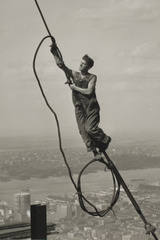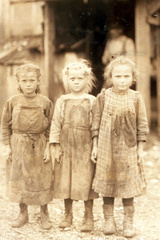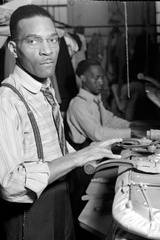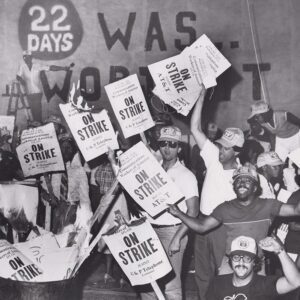October 31, 2013
Photographer Honored Workers, Helped End Child Labor
In August, the Postal Service released a series of stamps honoring American workers. Many of the stamps’ images were captured in the 1930s by photographer Lewis Hine, whose pictures celebrate the skills, daring and dignity of the industrial workers who built the nation. But Hine was more than a gifted shutterbug: He was a committed social reformer who dedicated his talent to documenting the struggles of working families and ending the exploitation of children in the workplace.
Lewis Wickes Hine was born in Oshkosh WI in 1874. After losing his father as a young boy, he worked as a delivery boy, a janitor and an upholsterer to save money for college. While studying sociology and education in Chicago and New York City, Hine was influenced by many Progressive Era leaders who sought economic justice for working families.
At age 30 Hine began taking photographs while teaching at a private academy in New York City devoted to “social justice, racial equality, and intellectual freedom.” He captured the faces of newly-arrived immigrants at Ellis Island, and documented the poor conditions workers — including children — faced in the city’s sweatshops and tenements.
Child Labor
 In 1906, he quit teaching to photograph life in Pittsburgh’s steel industry for the Russell Sage Foundation, participating in a pioneering study that showed a wide gap in the living and working conditions faced by the city’s workers and its comfortable middle class. In 1908 Hine became a full-time investigator and photographer for the National Child Labor Committee (NCLC), an organization supported by labor activists, clergymen, professors and philanthropists who sought to focus public attention on the plight of working children.
In 1906, he quit teaching to photograph life in Pittsburgh’s steel industry for the Russell Sage Foundation, participating in a pioneering study that showed a wide gap in the living and working conditions faced by the city’s workers and its comfortable middle class. In 1908 Hine became a full-time investigator and photographer for the National Child Labor Committee (NCLC), an organization supported by labor activists, clergymen, professors and philanthropists who sought to focus public attention on the plight of working children.
Over the next decade, Hine traveled the nation extensively to compile evidence that documented — and put real faces on — child labor. To gain access to sweatshops and factories where children were employed, Hine often had to pose “as an insurance agent, bible salesman, postcard seller, or industrial photographer,” one biographer noted. Hine used his teacher’s skills to get children to tell him their names, ages, and about their working conditions and lives.
Hine’s photographs illustrated pamphlets and magazine articles, and he displayed them during the many lectures he delivered. “Perhaps you are weary of child labor pictures,” he told one audience. “Well, so are the rest of us, but we propose to make you and the whole country so sick and tired of the whole business that when the time for action comes, child labor pictures will be records of the past.”
Hine’s photographs “helped win passage of child-labor laws — they constituted proof that the conditions the NCLC wrote about actually existed and they made the plight of the children real,” authors Lee D. Witkin and Barbara London wrote in a 1979 essay.
After 1917, Hine left the NCLC to work independently, focusing on the struggles of everyday people during the tumultuous years of World War I and rapid industrialization. He photographed the devastation in Europe for the Red Cross, then returned home to work for the Amalgamated Clothing Workers Union and a host of other organizations seeking to improve workers’ lives.
In 1930, Hine was commissioned to photograph the construction of the Empire State Building. In his late 50s, Hine climbed the exposed framework with the ironworkers and hung precariously from a basket to capture images of them securing steel beams 1,000 feet above New York City’s Fifth Avenue.
Many of the iconic images he captured were reproduced in national news magazines and symbolized the pluck and savvy of American workers as the nation struggled to emerge from the Great Depression. “Some of them are heroes; all of them persons it is a privilege to know,” Hine recalled.
Died Penniless
 In the late 1930s, interest in Hine’s work declined, as did his health. Despite his groundbreaking technical skills and the significant social impact of his photographs, Hine died penniless and unappreciated at 66, in November 1940.
In the late 1930s, interest in Hine’s work declined, as did his health. Despite his groundbreaking technical skills and the significant social impact of his photographs, Hine died penniless and unappreciated at 66, in November 1940.
Like many great artists before him, however, Hine gained wider recognition many years after this death. Today his photography is the subject of dozens of books; his work is often exhibited at art shows and many thousands of the images he captured can be seen online.
“There were two things I wanted to do,” Hine once said. “I wanted to show the things that had to be corrected; I wanted to show the things that had to be appreciated.”
To see more of Hine’s photographs, visit the Library of Congress photo archives to view the images he created for the National Child Labor Committee, and the George Easman House web site to see other his other work.



